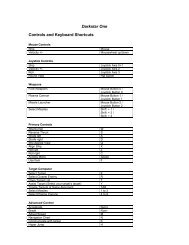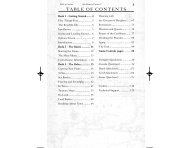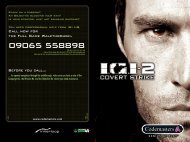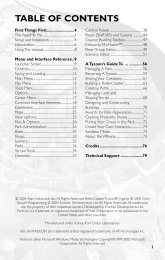Heads-Up Display Modes 35 - Metaboli
Heads-Up Display Modes 35 - Metaboli
Heads-Up Display Modes 35 - Metaboli
You also want an ePaper? Increase the reach of your titles
YUMPU automatically turns print PDFs into web optimized ePapers that Google loves.
68 Sensors<br />
SENSORS<br />
In many aerial battles, the victim never saw the attacker. Technological<br />
advancements now let the pilot “see” targets as far away as one hundred miles.<br />
Radar, laser, and infrared sensors extend the pilot’s view, giving “first look, first<br />
shot” capability.<br />
4.001 Radar<br />
Radar is an active sensor, meaning it broadcasts energy. This energy travels<br />
through the air, strikes targets, and is reflected back to the emitter. The radar<br />
measures how long it takes the pulse to return, the angle of the radar antenna,<br />
and the frequency shift of the returned pulse. Comparing multiple returns over<br />
time lets the radar calculate the target’s range, altitude, speed, heading, aspect<br />
angle, and closure rate.<br />
Radar is not perfect, though. As the pulse travels through the air, it loses energy.<br />
When it bounces off a target, it loses more energy. Traveling back to the emitting<br />
aircraft, it loses yet more power. Successfully detecting a target requires the<br />
return pulse having sufficient energy to be detected by the radar system. The<br />
more amount of energy reflected by the target is called the Radar Cross-Section<br />
or RCS. The larger the RCS, the farther away the target can be “seen.”<br />
hThe larger the object’s RCS, the greater the range at which it can be<br />
detected.<br />
Modern radar relies on the Doppler Effect and the resulting frequency shift in the<br />
return pulse to glean information about the target. To minimize “clutter” caused by<br />
reflections from the ground, radar systems filter out stationary targets based upon<br />
measuring the Doppler shift in the return pulses. Unfortunately, this same<br />
mechanism filters out aerial targets flying perpendicular to the emitter. This is<br />
known as “beaming” the radar and is an effective tactic to break hostile radar lock<br />
ons.<br />
h“Beaming,” or flying perpendicular to a radar emitter, is an effective<br />
tactic against Doppler-based radars.<br />
Radar does not cover the entire sky. Imagine searching for armed opponents in a<br />
large, darkened room filled with furniture with only a small penlight to guide you.<br />
The flashlight beam covers a very small percentage of the room, so you must<br />
move it around a lot to avoid obstacles and prevent the bad guys from sneaking<br />
up on you. Likewise, the radar system must move the beam as it scans the sky.<br />
However, the larger the volume of the scan pattern, the longer it takes the radar to<br />
complete a single scan. Fast-moving, nimble fighters might pass through the<br />
scanned area undetected if the scan pattern is too large.<br />
Unfortunately, using a flashlight in a darkened room reveals your position to your<br />
adversaries. Likewise, radar emissions announce your presence to everyone<br />
around. Most modern combat aircraft carry Radar Warning Receiver (RWR) gear<br />
that listens for and analyzes radar emissions. By measuring the characteristics of<br />
the received pulse, the RWR can often identify the radar system and therefore<br />
identify the opponent’s aircraft type.<br />
Radars operate in a variety of modes, varying the rate pulses that are transmitted<br />
and the size of the scan pattern. The number of pulses emitted per second is















